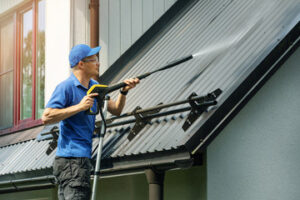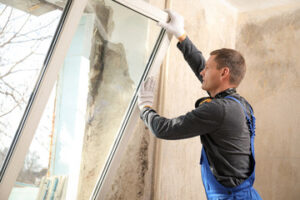Roof Cleaning may seem like a minor task. But it affects more than just how your home looks. Dirt, moss, and algae silently eat away at roofing materials. Left unchecked, they can shorten a roof’s life span by years.

Every roof holds secrets beneath its surface grime. These secrets include the slow spread of mold and mildew. Moisture traps itself between layers and creates unseen structural issues. Over time, these small issues become costly repairs.
The process of roof cleaning isn’t just a rinse. It involves choosing the right technique based on the roof’s age and type. Pressure washing might work for one home and destroy another. A careful hand is just as important as a powerful one.
Weather conditions play a key role in roof buildup. In humid zones, algae forms dark streaks. In dry regions, dust accumulates in corners. These particles blend into surfaces and make the roof appear aged.
A dirty roof isn’t just dirty—it’s dangerous. Wet leaves and moss create a slippery surface. Anyone trying to inspect or repair the roof risks slipping. It becomes a hazard without any obvious warning.
Roof cleaning can improve your home’s efficiency. A dark, dirty surface absorbs more heat from the sun. This raises indoor temperatures and increases cooling costs. A clean roof reflects light and regulates warmth better.
Pests love hiding in debris-covered roofs. Rodents nest in gutters and cracks. Insects burrow under damp shingles. Cleaning removes these habitats and prevents future infestations.
Roof cleaning also helps you spot problems early. It reveals small cracks or broken tiles. You can act before the next heavy rain causes a leak. Prevention is always cheaper than repairs.
Neglecting your roof affects curb appeal more than you’d expect. The roof often takes up half of your home’s exterior. A clean, bright surface transforms your house instantly. Even neighbors notice the difference.
Homeowners are now exploring eco-friendly cleaning options. Biodegradable solutions reduce harm to plants and water systems. Some use soft washing with low-pressure sprays. These methods are safer for both the roof and the planet.
Moss removal requires more than brushing it off. Its roots dig deep into shingles. If removed improperly, it damages the material. Specialized treatments help dry it out before gentle removal.
Each type of roof has unique needs. Tile roofs may crack under heavy pressure. Asphalt shingles lose granules if scrubbed too hard. Metal roofs demand different detergents to avoid corrosion.
Timing matters when cleaning your roof. Spring and fall are usually the best seasons. The weather is mild and predictable. It also allows you to remove debris from changing seasons.
Insurance adjusters check roof conditions during evaluations. A clean roof proves that maintenance was performed. It can support claims and protect policies. Neglect could even void coverage in some cases.
Property values are influenced by small details. A roof free from streaks and stains signals care. Buyers associate cleanliness with longevity. A clean roof can tilt their decisions in your favor.
Many people delay roof cleaning due to cost fears. But regular maintenance saves money long-term. Clean roofs don’t need early replacements. Small investments now avoid major expenses later.
Some roofs gather more debris because of nearby trees. Branches shed leaves and drop seeds. Birds also leave behind residue that builds up quickly. Keeping trees trimmed helps reduce this issue.
Airflow improves when debris is cleared from rooftops. Vents and eaves work better without blockages. This improves attic ventilation and reduces mold risk. Cleanliness enhances the entire home ecosystem.
Clean roofs contribute to mental well-being. Living in a tidy space offers peace and pride. A dirty roof, even if unnoticed, lowers aesthetic satisfaction. Maintenance boosts mood in ways we rarely acknowledge.
Communities are starting to promote roof hygiene. Some even offer incentives for regular upkeep. Clean roofs improve neighborhood appearances. They also prevent shared pest problems from spreading.
Roof cleaning tools have advanced recently. Brushes now come with adjustable handles. Sprayers feature better control and gentler force. These innovations make the task safer and more effective.
Learning how to clean a roof properly matters. Videos and tutorials are helpful, but safety comes first. Harnesses and non-slip footwear reduce risks. Never underestimate how dangerous a simple job can be.
DIY roof cleaning requires a plan. Pick the right day, gather supplies, and test your method on a small patch. Use ladders correctly and stay aware of your footing. Preparation separates success from accidents.
Some cleaning jobs need professional help. If the slope is too steep or material too delicate, don’t risk it. Experts bring both tools and experience. Their work ensures deeper cleaning and fewer mishaps.
Regular cleaning extends roof warranty periods. Many manufacturers include maintenance in their terms. Ignoring it may void the guarantee. Keeping a record of cleanings supports future claims.
Gutter cleaning is often tied to roof cleaning. When gutters overflow, water pools at the roofline. This accelerates decay and invites mold. A clean gutter protects both the roof and the foundation.
Moss and algae aren’t just cosmetic. They trap water, which leads to shingle rot. This can spread quickly during rainy seasons. Getting ahead of it saves serious frustration.
Solar panel performance depends on roof condition. A grimy roof lowers energy efficiency. Dirt casts shadows and reflects less light. Cleaning boosts both the roof’s look and the panel’s output.
Noise levels inside a home can be linked to roof buildup. Damp debris amplifies outside sounds. Proper drainage quiets the roof during storms. A clean roof can reduce this hidden source of stress.
Storm preparation includes roof cleaning. Debris blocks water runoff, increasing pressure on weak areas. Before the season changes, inspect and clean thoroughly. This small step may prevent major damage.
Bird droppings are highly acidic. They corrode roofing surfaces quickly. If ignored, they stain permanently. Regular roof washing removes these hazards before they cause harm.
Proper roof care includes more than just a hose. Detergents must be selected based on the surface. The wrong formula might cause fading or breakdown. Always read labels or consult experts.
Some roofs include skylights or solar tubes. Dirt collects around the seams and causes leaks. These areas need delicate cleaning. A gentle wipe with the right product prevents cracking.
Roofs with multiple levels trap debris in hidden spots. The areas between slopes collect the most buildup. These need more frequent checks. Ignoring them leads to quick deterioration.
Fungus loves moist environments. Once it grows, it’s hard to remove. Roof cleaning breaks the cycle before spores spread. This protects your health as well as the building.
Roof longevity is tied to exposure levels. A shaded roof holds moisture longer. Cleaning removes what the sun can’t dry out. You must adapt cleaning frequency to sun exposure.
A clean roof also complements your landscaping. Bright surfaces reflect garden colors. It gives your home a fresh, complete look. Even passersby notice when everything aligns beautifully.
Some homeowners discover damage only after cleaning. This is a blessing in disguise. Early detection saves time, money, and worry. Each cleaning becomes a mini inspection.
Water damage often starts from clogged roofs. Leaks travel down walls and into basements. A simple buildup becomes a disaster. Routine cleaning breaks this chain.
Dark roof stains are sometimes mistaken for age. But it’s often just algae. A basic wash can make the roof look ten years younger. This refresh comes without major renovations.
Every home tells a story from the top down. A clean roof shows that someone cares. It creates a silent message of pride and discipline. First impressions truly begin above our heads.
Maintenance is a ritual, not a reaction. Roof cleaning embodies that philosophy. It’s about staying ahead of the problems. And choosing a future that’s brighter, cleaner, and safer.
Clean roofs invite the sky to shine brighter. They reflect sunsets and morning light. Each wash uncovers a little more beauty. And makes the home feel new again.

